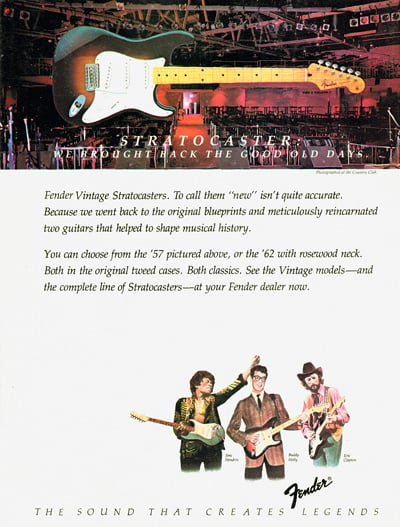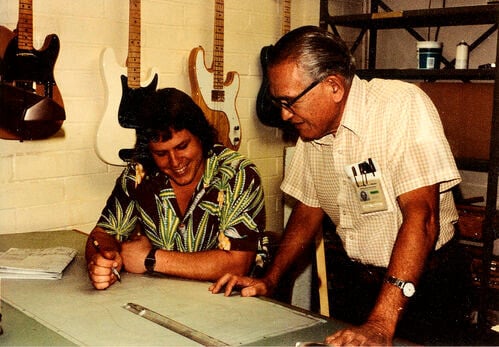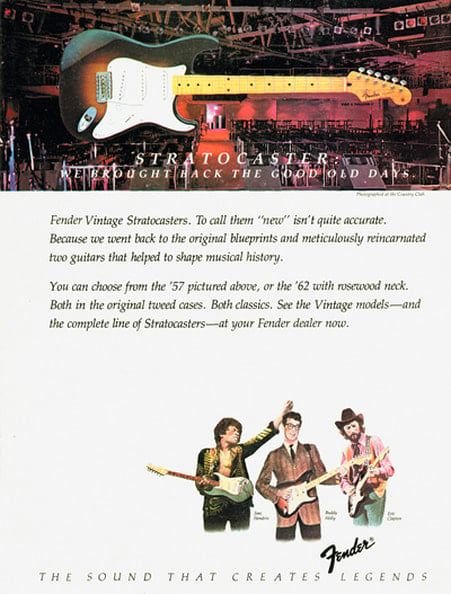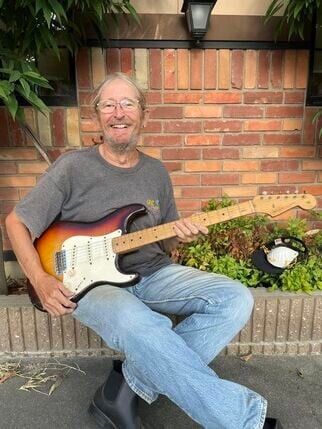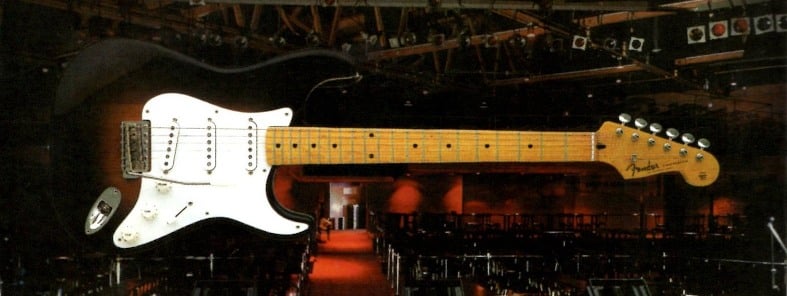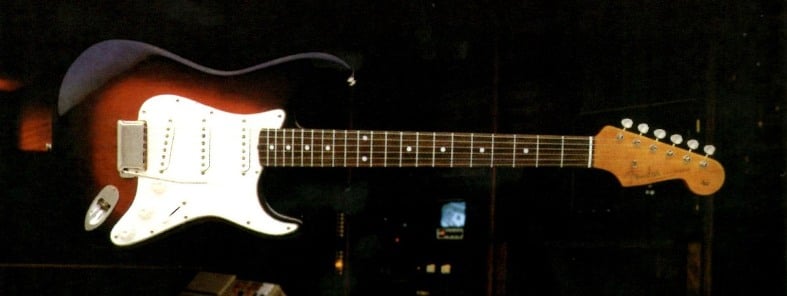THE ORIGIN OF THE VINTAGE stratocasters
Despite the innovations introduced with the Smith Strat, and the introduction of the Gold Stratocaster and the Walnut Strat, in the early '80s, the passion of guitarists towards the Stratocasters of the '50s and '60s showed no sign of diminishing.
In European markets, Tokai was hammering sales with superb low-priced vintage copies. Since it was difficult to protect Fender’s design from foreign competition, Bill Schultz and Roger Balmer (Fender’s then head of marketing and sales) decided to produce vintage-style Fender Stratocasters in Japan.
In European markets, Tokai was hammering sales with superb low-priced vintage copies. Since it was difficult to protect Fender’s design from foreign competition, Bill Schultz and Roger Balmer (Fender’s then head of marketing and sales) decided to produce vintage-style Fender Stratocasters in Japan.
|
So, in early '82, Fender entered agreements to have guitars made in Japan, after which it dramatically scaled down production at the Fullerton plant.
For a time, most Fender guitars were made - ironically but strategically - in the factories of its Japanese competitors. At the same time, Dan Smith thought Fender should also build in the USA a new line of Vintage reissues, even if they couldn’t make them in quantity, including the’52 Telecaster being developed by Freddie Tavares, along with the ’57 and ’62 Strats as well as Precision and Jazz basses. |
Dan Smith and John Page designed the first prototypes of the '57 Stratocaster and '62 Stratocaster in 1981, after visiting Larry Hendrikson’s store, the Ax-In-Hand, in Illinois, where they found a large collection of about 200 old Fenders.
Here they tested and analyzed many pre-CBS Stratocasters, to be used as a base for the Vintage Stratocasters.
Here they tested and analyzed many pre-CBS Stratocasters, to be used as a base for the Vintage Stratocasters.
|
“We knew that the best thing for Fender to bring out to show people that we were back was to reissue what everybody loved, which is why we did the ‘57s and ‘62s and all that kind of stuff. So, we looked at a lot of vintage guitars”, Dan Smith said. “I’ll never forget John and I going to DeKalb, Illinois, where we’d found that Larry Henrikson at Ax-In-Hand had about 200 Fenders in place. So, we went there, landed in Chicago in January, freezing cold, about 70 below. Can’t remember how many hire cars we went through before we found one that worked. Finally, we get to Larry’s shop and spent a whole day there. We were there on the mission to make sure we measured the stuff and got the data. We wanted to get it as close as we could. We took pickguards off, took pictures of pockets, tested paint, measured necks, all that kind of crap. And we left having bought perfect examples of each era, too. I remember we spent $5,600 on three guitars, which for Fender at the time was ludicrous. We went out and bought back our own product!”
|
John Carruthers, a famous luthier who customized and repaired instruments for some of the most acclaimed musicians, helped Dan Smith on the Vintage Reissues project, measuring many vintage Fenders, re-specing the reference standards, and helping to update or replace at least some of the worn-out tooling.
However, there was a problem regarding vintage-style pickups because Fender didn't know anymore how to make them. Obviously, Abigail Ybarra could reproduce the way they were manufactured, but there was no technical data. This is why Seymour Duncan entered the picture. He was an old friend of Fender and was very helpful in sharing his knowledge. There was also a rumor that Fender reciprocated when Seymour asked if he could see Seth Lover's files and specs from when he worked at Fender.
However, there was a problem regarding vintage-style pickups because Fender didn't know anymore how to make them. Obviously, Abigail Ybarra could reproduce the way they were manufactured, but there was no technical data. This is why Seymour Duncan entered the picture. He was an old friend of Fender and was very helpful in sharing his knowledge. There was also a rumor that Fender reciprocated when Seymour asked if he could see Seth Lover's files and specs from when he worked at Fender.
|
The prototypes were built by Senior Luthier Scott Zimmerman in 1981 and they were presented at the Anaheim NAMM in January 1982. Officially called Vintage Stratocasters, the new models’ serial numbers began with a special “V” prefix. The ’57 reissue had a single-layer pickguard and fretted maple neck, while the ’62 featured a 3-ply pickguard and maple neck with rosewood fretboard. However, the reissues were distributed later, only at the end of the year, because the entire Fullerton factory industrial plant was converted in order to produce much less than the daily 250-300 guitars realized in the '70s, thus improving quality control.
Although it may seem ironic that a pair of “old” designs were among the most important instruments ever made by a manufacturer renowned for innovation, these two reissues proved that Fender was still able to make excellent instruments. According to Dan Smith, the sales of those guitars would afford Fender the ability to develop the Standard line and the Elites, which pushed the envelope with modernism and ultimately led to the creation of the Custom Shop. |
Accurate reproductions or not?
According to Fender, the Vintage Stratocasters were exact replicas of the originals, but actually, they were not an accurate reproduction of vintage instruments. For example, the headstock was slightly different from the pre-CBS one and lacked the patent numbers, the ’62 model didn’t feature a mint green pickguard, nor the clay dots, and also pickups, string trees, and neck shape were different.
In fact, even though they had all the real-deal bits and pieces, and could have accurately reproduced vintage models, dealers were adamant that players wouldn't respond.
“There ended up being a lot of things that were not very accurate, by design, because players at the time didn’t care about deep-V necks and dot spacing - at least that was the feedback our marketing department was getting,” Page said. “Dan had to decide on things like neck shapes based on that, which is why we came up with the medium-C shape. “Another issue was finishes,” he added. “We started with 100-percent nitrocellulose, but when the first Vintage models came out, dealers complained about grain shrinkage and irregularities showing through. We told them, ‘Well, it’s lacquer, like vintage...” But they said, ‘Yeah, but we don’t want to see that.’ So, we started doing urethane undercoats with nitro top coats.”
Those concessions for the sake of marketability helped make the Vintage line successful.
In fact, even though they had all the real-deal bits and pieces, and could have accurately reproduced vintage models, dealers were adamant that players wouldn't respond.
“There ended up being a lot of things that were not very accurate, by design, because players at the time didn’t care about deep-V necks and dot spacing - at least that was the feedback our marketing department was getting,” Page said. “Dan had to decide on things like neck shapes based on that, which is why we came up with the medium-C shape. “Another issue was finishes,” he added. “We started with 100-percent nitrocellulose, but when the first Vintage models came out, dealers complained about grain shrinkage and irregularities showing through. We told them, ‘Well, it’s lacquer, like vintage...” But they said, ‘Yeah, but we don’t want to see that.’ So, we started doing urethane undercoats with nitro top coats.”
Those concessions for the sake of marketability helped make the Vintage line successful.
The catalog mystery
Looking at the distance of the 12th fret markers in the Vintage Reissue images in the 1982 catalog, it seems that these were faithful to the original pre-CBS guitars, while, actually, in the reissues this distance was not vintage-correct, because it would have cost too much to "redesign" the factory to maintain this detail. It seems paradoxical that the reissues made by Fender Japan in the same period had the right distance between the two fret markers!
So, what kind of guitars are those in the catalog? Dan Smith, John Page, Freddie Tavares and Scott Zimmerman all had input into the production prototypes and the collected from stores vintage examples. Dan Smith had been procuring and had some Japanese manufacturers samples branded Tokai amongst others. When the catalogue was being designed, Fender’s UK consultant was contributing and gaining clearances and approvals for the Artist’s photos and the layouts they were in working with Joe Phelps Advertising Agency and Dan Smith. Max Kay from EFR (Extremely Fucking Rare) Guitars was told by Tokai that the new Fender catalogue had photographs of Tokai guitars in. This wasn’t completely true, because there was only a picture of the back of a Tokai Strat headstock showing the machine heads and this picture you can clearly see in the catalogue has "TOKAI" embossed into the metalwork of the gear covers. When questioned about this bogus machine head by the European agents Dan Smith explained that was the only Tokai neck used and it was used just because it was around when the photographer was working but thankfully spotted during the approvals process of what has become regarded as probably the best and most coveted Fender catalogue ever printed.
So, what kind of guitars are those in the catalog? Dan Smith, John Page, Freddie Tavares and Scott Zimmerman all had input into the production prototypes and the collected from stores vintage examples. Dan Smith had been procuring and had some Japanese manufacturers samples branded Tokai amongst others. When the catalogue was being designed, Fender’s UK consultant was contributing and gaining clearances and approvals for the Artist’s photos and the layouts they were in working with Joe Phelps Advertising Agency and Dan Smith. Max Kay from EFR (Extremely Fucking Rare) Guitars was told by Tokai that the new Fender catalogue had photographs of Tokai guitars in. This wasn’t completely true, because there was only a picture of the back of a Tokai Strat headstock showing the machine heads and this picture you can clearly see in the catalogue has "TOKAI" embossed into the metalwork of the gear covers. When questioned about this bogus machine head by the European agents Dan Smith explained that was the only Tokai neck used and it was used just because it was around when the photographer was working but thankfully spotted during the approvals process of what has become regarded as probably the best and most coveted Fender catalogue ever printed.
FULLERTON VS CORONA
The first Stratocasters of the Vintage series were made in Fullerton from the first half of 1982 until January 1985, when this factory closed. It has been estimated that around sixteen thousand guitars of this type were built, known as "Fullerton Reissues", which are particularly desired by collectors, the reason why it’s so easy, unfortunately, to find fakes. Production had been moved to the new Corona factory at the end of 1985, and in 1998 the series was renamed American Vintage Series.
Antonio Calvosa

